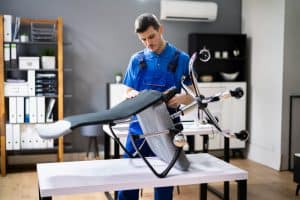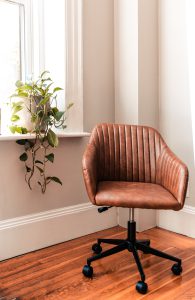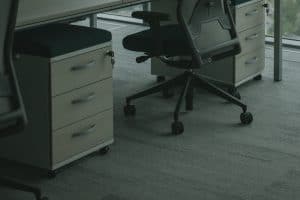How often are you afraid of moving around in your office chair in the middle of a meeting because of the disrupting squeaky noise it makes? It happens to the best of us, right? But there’s no reason you can’t find why it’s making the squeaking noise and then fix it accordingly.
Squeaky office chairs are extremely annoying, not just to the person sitting on them but also to the people around them. However, just because you have a squeaky chair doesn’t mean it is time to buy a new one. You can easily fix the existing one with the quick tips that we have accumulated in this article.
What are the Common Reasons Behind a Squeaky Office Chair?
Before discussing the common ways to fix a squeaky office chair, we must know what’s causing it in the first place.
Wooden Chairs
A wooden chair often causing a squeaky noise when some part of the chair is loose or the wood glue has become loose. If you have screws and bolts on the chair, check whether they are tightened or not. Even rusting over time causes make the chair squeaky.
Armchair
Rusty swivel wheels or loose legs are two of the primary issues behind a squeaking armchair. Often, even the foam’s springs are responsible for making the noise, but you might have to dig through the upholstery for that if that is the case.
Office and Gaming Chairs
The majority of the office and gaming chairs make a squeaky noise because of the impaired metal parts or the metal elements’ rusting in the chair. Constant friction is also a reason why your chair is likely making a squeaking noise.
How to Fix Squeaky Office Chair?
Depending on what is causing the squeaking noise, you can do a few things to fix the unwanted noise from the desk chair.
1. Oil the Metal Parts
Especially for the office chairs made of metal and metal chair parts, you must oil those parts, especially around the screws, springs, and bolts. Before oiling, make sure all the parts are tightened further to reduce any chances of noises from the chair.
Applying lubricating oil loosens the joints and prevents further friction that could be contributing to the noise. Timely lubrication helps reduce the risks of rusting, too, by preventing the moisture from interacting with the metal’s surface.
2. Replace the Rusted Parts
Since office chairs are mostly made of metal, you need to determine the problem areas and then find the rusted parts on the chair. Sometimes, you can sit down and clean the rusted parts on the chair first. Use a clean cloth or steel wool to rub the rust off the chair. You can also dip a clean cloth in some white vinegar to clean the rust.
In case some of the rusted metal parts like the height adjustment knob, swivel wheels, and the tension spring are beyond cleaning, you can then think about replacing them for good. But, ensure that you spray the replaced parts with a rust deterrent once they are fixed.
3. Focus on Tightening the Springs in the Back of the Chair
One of the primary solutions for the constant squeaking noise from your office chair is to check the springs and screws in the back of your chair.
If you find the chair only squeaking when you are reclining back, it is a sign that your chair needs immediate fixing. The best way to fix that is by generously applying some lubricating or mineral oil onto the seat tension spring located around the turn knob. For best results, loosen the seat tension turn-knob first and then apply the oil generously.
4. Lubricate the Moving Parts
Not just the stationary parts in the office chair, even the moving parts could contribute to the squeaking noise. The swivel wheels especially tend to accurate dirt, hair, and rust from the surroundings, making it wear off. Even a poorly constructed office chair could contribute to the noise that you are noticing consistently.
Ensure that you spray the moving parts’ surface, including the wheels and the reclining adjustments, with some WD-40 as a preventive measure against rusting. Also, lubricate any stationary elements like screws and nuts before you tighten them into the chair. This can effectively reduce the constant noise.
5. Apply Glue to Loose Joints
If you have a squeaky wooden office chair, the wood likely has either loosened or fluffed up due to water and the moisture in the air. You can easily apply some good-quality wood glue to stabilize the loose leg joints easily. For better view and access, turn the chair upside down to check unnecessary loose joints.
Once you find the loose joint, fill the gap with some wood glue and let it dry before turning the chair upright again for usage. Make sure that you wipe out excess glue from the sides of the chair’s joints. If there is a lot of open space around the joints, try mixing some wood fillers into the glue before adding it to the loose joints to restore the chair’s stability.
6. Replace the Wooden or Nail Joint Plugs
Another effective way to eliminate the squeaking noises from your office chair is by replacing the joint plugs. The hardware in the chair often wears off with time. Instead of cleaning them or not paying close attention to them, you can always inspect each element and then replace them with new ones. The joint plugs are the most susceptible to damage over time, so make sure you replace them first.
Also, ensure that you use some good quality lubricant to fix a squeaky chair. When replacing them, make sure that put in screws that are long enough to get into the deeper part of the wood to hold its place without coming out from the other end. If possible, check the screws and bolts of the joint plugs as well.
7. Ask a Friend for Help
If you cannot locate the exact cause of the squeaky noise, you must have a friend sit down on the chair and ask them to swivel the chair from side to side. While they do that, check for the source of the noise.
Once you find the source, you can apply oil generously on the site. Ask the participant to move for a few minutes while applying the lubricant to ensure that you can get to all the problem points and fix the sound completely.
8. Sit Slowly on the Chair
Office chairs are often used very rigorously, putting them at risk of constant wear and tear. If you have had an office chair for the last two years, it is likely that it has sustained a lot. So, instead of jumping and sitting on the chair, make sure that you are gentle while sitting down. This reduces the risks of impacts on the tension sprints and the joints in the chair. Doing so in the long run reduces the risks of damage imposed on the chair.
If possible, even adjust the chair gradually instead of being rough and not careful about it. Another factor that can help reduce the risks of wear and tear on the chair is by oiling it every few months and spraying it with rust-resistant sprays.
Conclusion
For the most part, the squeaking chair’s noise can get better once you apply oil in the right places and clean the rusty parts. But, if the sound persists and you can’t seem to reverse the problem at all, it is important that you either think about replacing the chair or the parts that are not working properly.





